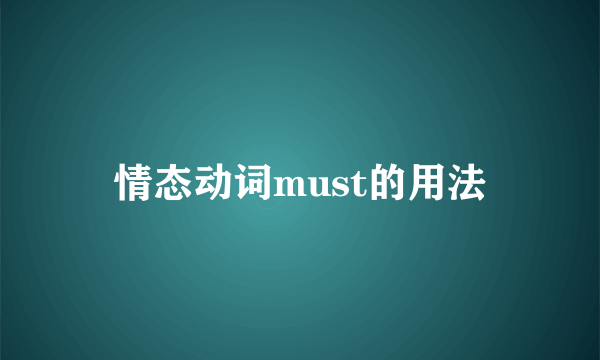
百弗高级语法课堂
have to v. aux.不得不,必须,后跟动词原形。强调客观需要;其过去式是had to,将来时态的形式是shall/will have to. 口语中也常说have got to. 它的特点是have有人称、时态的变化。
而must则表示主观愿望,主观看法,只能用于一般现在时和一般将来时。例:
We must finish the work before lunch.我们必须在午饭前完成这项工作。
(强调有义务早完成工作,不要拖延。)
We have to finish the work before lunch.
(强调客观情况迫使,如不完成就会……是不得以而为之。)
--- Would you like to come to my house on National Day?
--- Thank you, I’d love to. But I have to see my uncle on that day.
--- 你国庆节来我家好吗?
--- 谢谢你,我很愿意,但是我那天得去看我的叔叔。
I’m afraid I have to go now. 恐怕我得走了。(表示遗憾)
I must go now.我必须走了。(主观看法)
I have to go now.我不得不走了。(客观需要)
My mother was ill yesterday, so I had to stay at home.
昨天我妈妈病了,所以我不得不呆在家里。
She can''t come. She has to help her mum. 她不能来。她必须帮助她妈妈。
I have to go to a meeting now. 我现在得去开会。
We have to go to the office every day. 我们每天都得上班。
I shall have to stay here. 我不得不/只好呆在这儿。
have to 的疑问式和否定式通常借助助动词do (does)/did 等构成。例如:
You don''t have to worry about them any more. 你不必再为你们担忧了。
We don''t have to go to school on Saturdays and Sundays.
星期六和星期天我们不必去上学。
Do you have to leave so soon? 你必须这么早走吗?
What does she have to do? 她必须做什么?
They didn''t have to wait for him. 他们不必等他。
When he comes, I must/have to go. (现在时)
When she came, I had to go. (过去时)
注意:表示“必须”还有两个情态动词,should与ought to,例如:
You oughtn’t to write so carelessly. 你不应该写得如此粗心。
You should do as he says.你必须按照他说的去做。
can(could)意为“能,可以,可能”.can多用于指现在或将来.could多用于指过去式,但也可以用于指现在,表达的语气更委婉.用法有:表示能力;表示怀疑、猜测,常用于否定句和疑问句中;表示请求和允许,相当于may;表示可能性(can比could可能性大).
See if you can go with us.
考虑一下,看是否能和我们一起去。
What can I do for you?
我能帮你什么忙吗?
2.have to意为“不得不”.能用于各种时态.
You have to consider what to do next.
你必须考虑下一步该做什么。
You have to keep after your son if he refuses to be housebroken.
如果你儿子不服管教的话,你必须整天跟在他的身边。
3.must表示义务,意为“必须.应该”;表示推测,意为“一定”.一般用于肯定句;否定句中,mustn't表示禁止,意为“不允许”.
Then you must be my cousin.
那么你一定是我的远亲了。
You must compensate me for this loss.
你必须补偿我的这个损失。
1)强调重点不同
两者都表示必须,但must 侧重于说话者的主观看法,认为有必要或有义务去做某事;have to 则重于客观需要,含有不得不或被迫之意:
We must go at once.我们必须马上就走.
If I buy that car,l have to borrow some money.如果我要买那辆汽车,我得借些钱.
2)时态形式不同
must 只有现在时一种形式(在宾语从句中可以表示过去),而 have to 则有多种时态形式:
She said (that) she must go with me.她说她一定要同我一起去.
They have had to buy a car.他们不得不买了辆小汽车.
3)非谓语形式不同
have to 可以有分词、动名词、不定式等形式,而 must 则没有这些形式:
He only saw her in the evening,having to be away all day.他整天得外出,只能晚上见她.
I regret to have to trouble you again.我很抱歉不得不再麻烦你一次.
4)否定式的意义不同
must 的否定式 mustn‘t 意为一定不要、不允许;
而 have to 的否定式 don’t have to 意为不必(=needn‘t).比较:
You mustn‘t tell him about it.你一定不要告诉他这件事.(可能是秘密)
You don‘t have to tell him about it.你不必告诉他这件事.(他可能知道了)
must表示主观,have to表示客观。
We must help each other.
My sister is ill, my mother has to look after her.
must的用法
1)表示主观的义务和必要,主要用于肯定句和疑问句,意思为“必须……,得……,要……”;由must引起的疑问句,肯定回答要用must或haveto,否定回答要用needn’t或don’thaveto,意思是“不必”;must的否定形式mustn’t表示禁止,意思是“不能,不许”。
We must find a good method to learn computer well.
我们必须找一个学好电脑的方法。
2)表示肯定的猜测,常用于肯定句中,意思为“一定是,必然……”。
注意must表示推断或猜测的几种情况:
Your sister must be a doctor in this hospital.(现在的猜测)
你姐姐一定是这家医院的医生。
have to/have got to的用法
1)must表示一种主观的需要,而have to表示一种客观的需要,意思是“不得不”。如:
I have to attend an important meeting this afternoon.
今天下午我不得不参加一个重要的会议。
Mother is out,so I have to look after the shop.
妈妈不在家,因此我不得不照看商店。
2)have to的否定形式是don’t have to,相当于needn’t。如:
They don’t have to buy a computer at present.
他们目前没有必要买电脑。
3)have to与have got to常可以互换。
标签:must

















